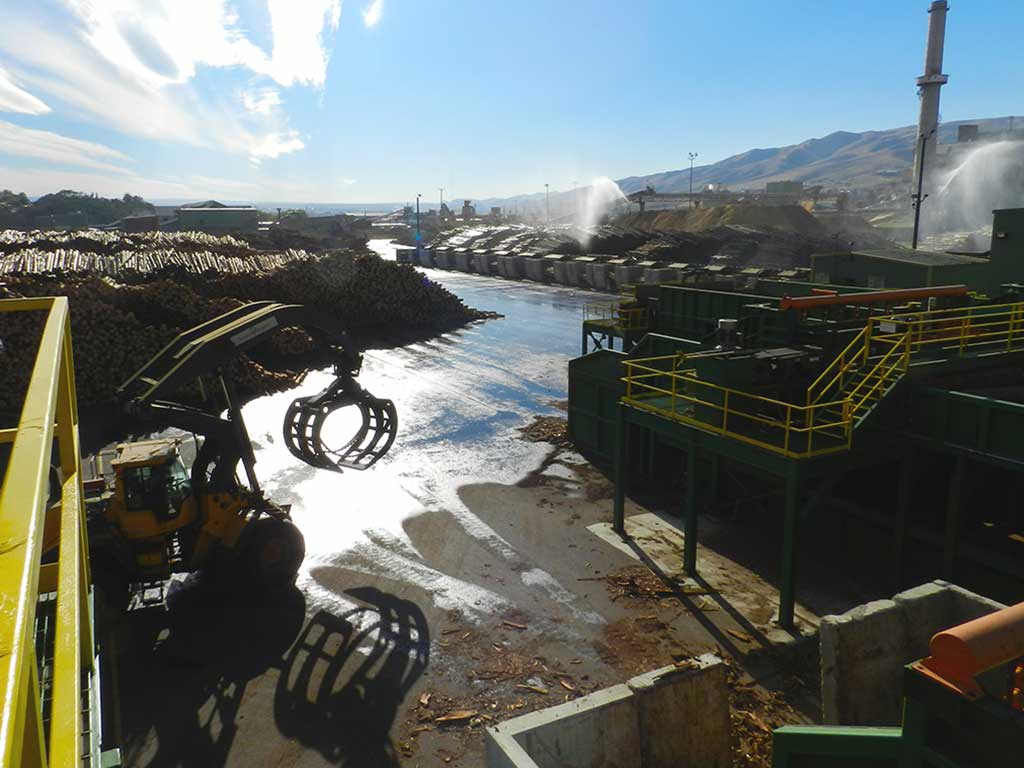Welcome to our new website!
Greetings Friends of Evergreen! Our new website is up and running and I think I have figured out how to

THE OPPORTUNITY OF A LIFETIME
“Technology does most of what strong backs and keen eyes did for generations. And it does it with more speed and efficiency than can any human. Of course, humans are the still ones invent, install and run this stuff, so the message here is that succeeding generations of mill workers will need to be technologically more knowledgeable than the previous generation.”
Jesse Short, Mill Manager Idaho Forest Group Lewiston, Idaho
Jesse Short got his first job in an Idaho saw mill by pestering the mill manager until he couldn’t stand it anymore.
“You’re becoming a real pain in the butt,” Jim Perry told Short one morning after he had shown up the fourth or fifth time in Perry’s office at the Louisiana Pacific saw mill in Moyie Springs. To end his suffering, Perry hired Short to clean toilets, offices and mill debris.
“I had gotten my first unemployment check and I didn’t want any more of them,” Short recalls. “I wanted to work.”
Today, little more than 20 years later, Short is manager of the Idaho Forest Group’s new Lewiston sawmill, arguably the most technologically advanced sawmill on Earth. And he helped design it. Not bad for a young man from a northern Michigan town so small that he had to take a bus to a neighboring town that had a high school.
After he graduated from West Branch High School in 1995, he entertained the idea of making his first million in homebuilding and real estate. He got his builder’s license through Delta College in Saginaw, Michigan, but was horribly disappointed in how easy it was to get a builder’s license. What to do?
“I had a friend whose family hunted elk around Bonners Ferry every year,” Short recalls. “They sold everything and headed west, thinking they’d settle there, but they never got any further than Libby, Montana. I went out to visit and fell in love with the place.”
Short worked briefly in construction around Libby, only to learn to his dismay that the work was seasonal. Thus began his pestering of Jim Perry in Moyie Springs.
“I soon graduated from cleaning toilets to shoveling wood chips,” Short says. “I didn’t know the first thing about sawmills, but back home in Michigan, my teachers had preached devastation of the West’s forests, and watching all of those log trucks come into the Moyie Springs log yard every day didn’t do anything to change my mind. I began to wonder if I didn’t have another short term job.”
In hopes of easing his mind, Short asked the company’s Moyie Springs’ forester if what he’d learned in school was true. He was quickly dispatched to Bob Schrenk’s office in Libby. Schrenk, who was then Kootenai National Forest supervisor, assured Short that there was no basis for his fears. Properly managed, the region’s federal forest lands would never run out of timber.
That LP’s Moyie Springs management team would send Short to Libby to assuage his fears said something about the potential they saw him. He was soon promoted to production manager on the graveyard shift. Not long afterward, Louisiana Pacific sold its mills at Moyie Springs and Chilco to Marc Brinkmeyer. Short just kept working.
“There was a lot of excitement over the change in ownership,” Short recalls. “LP had neglected the mill for several years, so there was a lot of maintenance catching up to do, and we were pretty far behind on technology. Marc also brought us a new emphasis on worker safety. “
Short soon became day shift supervisor, then mill manager.
“It was quite a transition for me,” he says. “When you work graveyard, you never see anyone except the rest of the crew, so when I moved over to the day side, I got my first real exposure to our customers. Addressing customer needs is where the rubber meets the road. And it’s a lot of what I do now.”
When Riley Creek and Bennett Forest Industries merged to form the Idaho Forest Group in 2008, Dick Bennet’s grandson, Scott Atkison, became the new company’s president. Atkison, like Jim Perry years before him, saw something in Short that he liked very much, so when IFG purchased Clearwater Paper’s Lewiston sawmill, Atkison asked Short if he’d like to run the Lewiston mill.
“It was the opportunity of a lifetime,” Short recalls. “I was soon working side-by-side with Scott, Marc and Allen Selander on a new mill design and construction project that took us four years to complete.”

“Design and construction” barely describe IFG’s $85 million rebuild of Potlatch’s historic Lewiston mill. Among the marvelous array of computer-driven processes is a CT scanning machine identical to that used in Lewiston’s hospital. Worldwide, it is one of only two such scanning and optimization systems used in a saw mill.
IFG uses its computed tomography [CT] scanner to x-ray every log the mill processes. It uses the scanner’s three-dimensional images to locate knots [green or dry], splits, cracks, wind shake, rings per inch, grain distortions or foreign objects that lay hidden beneath tree bark.
“Once the scanner gathers its information, it computes a sawing solution for each log before it is routed to our small diameter mill or our big log mill,” Short explains. “Logs up to 18 inches in diameter on the big end go to our Hew Saw and logs between 18 and 30 inches go to our big mill. We sell our larger logs to smaller specialty mills like Tripro and Empire Lumber.”
On the Hew Saw line that Short helped design, there are 28 different log sorts based on tree species, diameter, taper and length; but that’s nothing compared to the 1,200 sawing solutions stored in the Hew Saw’s brain.
It is not possible to walk as fast as the conveyor chain that carries logs from the CT scanner to their final destinations at either the Hew Saw or the big mill. Nor is it possible to visually count the two-by-fours that the Hew Saw spits on to a long conveyor system that delivers them to a stacking system that bundles them for planers that will smooth their surfaces before they are dried in biomass-heated steam driers.
Perhaps most revealing is the number of workers who occupy stations between the towering crane that delivers logs to the CT scanner and the two mills that process them. There are five, including two who run massive loaders that deliver logs to the crane. They handle 13,000 logs daily – 12,000 for the Hew Saw and 1,000 for the big mill.
“Men don’t do much of the heavy lifting in mills anymore,” Short explains. “Technology does most of what strong backs and keen eyes did for generations. And it does it with more speed and efficiency than can any human. Of course, humans are the still ones invent, install and run this stuff, so the message here is that succeeding generations of mill workers will need to be technologically more knowledgeable than the previous generation.”

Currently 178 work full time for IFG at Lewiston, plus another 200 or more logging and trucking contractors that harvest and deliver some 230 truckloads of logs to the mill daily. The facility processes about 280 million board feet [lumber scale] annually. Measured in lumber scale, a hypothetical board foot is a board one foot long, one foot wide and one inch thick.
Short reports that IFG’s owners are so concerned about the lack of qualified workers that they have implemented a tuition reimbursement program for skilled trade and they are partnering with North Idaho College, Lewis and Clark State College and Walla Walla Community College on a matching funds grant program that that will train workers in log scaling, programmable logic controllers, fluid power, information technology, mechanics and safety training professionals.
Although Short now divides his time between customer relations and the mill’s dazzling array of technologies, he is keenly aware of the Lewiston mill’s debt to its surrounding communities.
“IFG does not function in a vacuum,” he explains. “We owe much to the communities where our employees live, so we do our best to support volunteerism, especially youth activities: 4-H clubs and livestock auctions, sports, county fairs, the Boys and Girls Club, food banks and homeless shelters. Obviously, there is more need than we have people.”
Short and his wife, Jennifer – the other bonus he found in Libby, Montana – have two sons, Jayden, 15 and Connor, 11.
“I have a wonderful and very understanding wife,” he says of all the jockeying around that has come with his mercurial rise at IFG. “I would not be here if it wasn’t for her support. As you might imagine, it’s been quite a ride.”
Indeed it has. It is 2,043 miles across a cultural chasm from tiny Lupton, on Michigan’s Lower Peninsula, to Lewiston, Idaho, where he oversees a saw mill unlike any other in the world. His father farmed and had a combination tire store and repair shop in Lupton. Short and his three brothers grew up helping him.
You 100% tax-deductible subscription allows us to continue providing science-based forestry information with the goal of ensuring healthy forests forever.